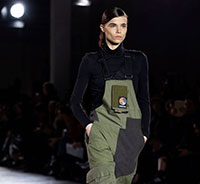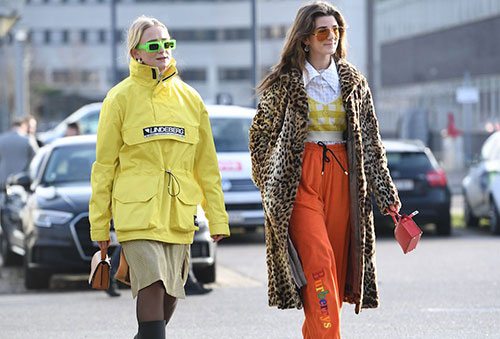FW
An off-white denim created by retailer C&A, Pakistan textile mill Rajby Textiles and circular economy consultants Eco Intelligent Growth (EIG) has become the world’s first to receive a platinum Cradle to Cradle certification.
Beluga denim is made from 100 per cent Global Organic Textile Standard (GOTS)-certified organic cotton fiber, is fully recyclable and is produced using a specially-designed closed-loop water system. It is 100 per cent carbon neutral in the final manufacturing stage.
To achieve the highest level Cradle to Cradle certification, Rajby and C&A worked together to research and identify the most suitable materials and chemicals for the ecru fabric. The denim had to be made entirely of safe and rapidly renewable ingredients, both fibers and chemicals, which meant that no oil-based dyes, auxiliaries or other chemicals could be used. Rajby and C&A also worked closely together to ensure that Beluga would be actively cycled into new product after its usable lifetime, instead of becoming waste. The fabric was tested to ensure it met the highest-level requirements for all five Cradle to Cradle categories: material health, material reutilisation, renewable energy and carbon management, water stewardship and social fairness. C&A is expected to launch the first garments made with Beluga denim in about four months.
The outbreak of novel coronavirus triggers run on medical and health textiles, driving the production of non-woven at full throttle across the country, particularly in Xiantao city, Hubei Province, best known as China Famous City for Non-Woven, a city home to over a hundred of non-woven manufacturing companies.
According to the city government, there are 137 companies producing protective gear, of which
113 companies are specialized in medical and health textiles. As of February 9, 83 of them have resumed production in Spring Festival holidays to respond to demand urgency at a time when the whole country is mobilized to fight coronavirus. Among these 83 working manufacturers, 10 companies work on medical and health garment, 28 on non-woven, 45 for face masks and protective clothing, leaving 30 companies yet to go into production after in-situ qualification survey and accreditation by expert procedures.

To stand up to the public health emergency, local government plays a very important role in marshalling resources through organizational efficiency and responsible leadership in stepped-up efforts to quickly resume production in time of need. The update on February 8th shows that the daily output of protective clothing has reached 30,000 pieces, a target set by provincial government, temporarily easing the shortage of supply.
Furthermore, the city government of Xiantao issued [Regulation on Production Order for Non-Woven Manufacturers] to make sure that the existing protective textiles companies measure up to the industrial, social and environmental standards in all perspectives on corporate-compliant basis, particularly in terms of the licenses for hospital appliances production and the registration certificate for medical and health supplies, enabling health-purposed products themselves to be healthy in a quality-centered supply chain.
Contributed by Mr. ZHAO Hong
He is working for CHINA TEXTILE magazine as Editor-in-Chief in addition to being involved in a plethora of activities for the textile industry. He has worked for the Engineering Institute of Ministry of Textile Industry, and for China National Textile Council and continues to serve the industry in the capacity of Deputy Director of China Textile International Exchange Centre, V. President of China Knitting Industry Association, V. President of China Textile Magazine and its Editor-in-Chief for the English Version, Deputy Director of News Centre of China National Textile and Apparel Council (CNTAC), Deputy Director of International Trade Office, CNTAC, Deputy Director of China Textile Economic Research Centre. He was also elected once ACT Chair of Private Sector Consulting Committee of International Textile and Clothing Bureau (ITCB)
"Marked by an unrelenting and disruptive consumer revolution, the past decade made mobility a make-or-break factor for fashion retail businesses. Factors responsible for this change included demographic shifts, rise of the smartphone, the ubiquity of the internet, the changing role of stores and competition from unexpected rivals."
 Marked by an unrelenting and disruptive consumer revolution, the past decade made mobility a make-or-break factor for fashion retail businesses. Factors responsible for this change included demographic shifts, rise of the smartphone, the ubiquity of the internet, the changing role of stores and competition from unexpected rivals.
Marked by an unrelenting and disruptive consumer revolution, the past decade made mobility a make-or-break factor for fashion retail businesses. Factors responsible for this change included demographic shifts, rise of the smartphone, the ubiquity of the internet, the changing role of stores and competition from unexpected rivals.
Reevaluating the fundamentals of their businesses, retailers noticed certain factors like a transition from a linear to circular economy, globalisation of supply chains, explosion of cities and the need for sustainable energy testing the trust of their customers. As a recent Lifestyle Monitor survey revealed, though the expenditure of customers on apparels increased significantly in last 10 years, their mode of shopping changed. While in 2009, around 32 per cent consumers spent most of their money on shopping from brick and mortar stores. By, 2019, this figure dropped to 24 per cent with around 43 per cent consumers preferring to shop online.
Informed consumers lead to change in retail models
The decade also brought about the democratisation of information and an informed consumer class. The concept of a retailer or a company promoting an idea to shift the paradigm became harder to execute as consumers were already aware of what they wanted to buy. They also have access to all materials that industry insiders use as runway shows are live streamed and look books are posted the moment they drop.
of a retailer or a company promoting an idea to shift the paradigm became harder to execute as consumers were already aware of what they wanted to buy. They also have access to all materials that industry insiders use as runway shows are live streamed and look books are posted the moment they drop.
An easy access to the internet also gives consumers innovative ideas to buy clothes online. As the Monitor™ survey revealed, last year around 38 per cent consumers got their clothing ideas online. On the other hand, the influence of store displays and windows decreased from 42 to 33 per cent. To meet changing needs, retailers started investing in mobility for top-down changes to their business models. They are delivering streamlined, personalised paths to purchase.
Digital disruption leading to store closures
A study commissioned by SAP in January 2019 assessed the adoption of intelligent technologies to support the digital transformation journey in the last decade. The research examined companies who were actively undergoing digital transformation and had already implemented at least two innovation technologies. The study revealed that digital disruption has taken a toll on the retail industry with thousands of store closures affecting everyone from mass merchants to luxury stores.
Although thousands of retail doors closed, many new stores opened, including previous online-only brands like Bonobos and Indochino. But another reality for the fashion industry is consumers aren’t purchasing as much as they used to. Their interest in quality has increased with around 51 per cent willing to pay more for better quality garments, a measurable increase from 47 per cent a decade ago, reveals the Monitor™ research.
Growing preference for cotton apparels
The preference for cotton apparel remained strong with nearly 79 per cent consumers preferring clothes made of cotton as against 3 per cent preferring silk and polyester each. Over 76 per cent consumers believe cotton garments to be of better quality compared to 49 per cent a decade ago. They prefer to shop from brands like Patagonia and Noah that have a point of view and ethos that squares with their own, as opposed to the label with the cheapest price.
Brands like Badgley Mischka, Levi’s, Adidas and Tapestry, who adopted SAP, have been able to make it through some of the retail’s roughest waters as they realised the value of intelligent digital transformation, enhanced mobility functionalities and an elevated customer experience.
In future, consumers will expect retailers to be more involved in their lives as trusted partners. To deliver on these expectations, retailers will need to earn their customer’s trust by embracing new technologies and being more creative about the services that they provide.
"For decades, United States has been inspiring designers to create new and innovative designs but now the growing influence of millennials and Gen Z is forcing them to look to other regions of the country for inspiration. As millennials value experiences over traditional markers of success and adulthood like home ownership, marriage and children, they are driven by tendencies like a nomadic lifestyle, wellness, spirituality and even psychedelia."
 For decades, United States has been inspiring designers to create new and innovative designs but now the growing influence of millennials and Gen Z is forcing them to look to other regions of the country for inspiration. As millennials value experiences over traditional markers of success and adulthood like home ownership, marriage and children, they are driven by tendencies like a nomadic lifestyle, wellness, spirituality and even psychedelia. Designers are capturing their desire for freedom in a series of crisscrossing trends, including: utility, wider silhouettes, workwear, outdoor, unisex fashion, natural dyes, tie-dye, sustainable fabrications and performance fabrics for lifestyle.
For decades, United States has been inspiring designers to create new and innovative designs but now the growing influence of millennials and Gen Z is forcing them to look to other regions of the country for inspiration. As millennials value experiences over traditional markers of success and adulthood like home ownership, marriage and children, they are driven by tendencies like a nomadic lifestyle, wellness, spirituality and even psychedelia. Designers are capturing their desire for freedom in a series of crisscrossing trends, including: utility, wider silhouettes, workwear, outdoor, unisex fashion, natural dyes, tie-dye, sustainable fabrications and performance fabrics for lifestyle.
A region that fulfills the desire of these designers is the Pacific Northwest where the natural beauty of Washington’s rainforests, Oregon’s windswept shorelines and snow-capped Mt. Hood coexist with a level of intelligence and imagination that rivals Silicon Valley. Hence, the fashion that comes out of this region is a mix of outdoor adventure and hoodie-wearing CEO. This look is grounded with garments like plaid shirts, utility vests and pants, puffer vests, polar fleece tops and CPO shirt jackets.
Loose fitting, nature-inspired patterns with rustic colors
For men, the nomadic look includes relaxed, loose fits, nature-inspired patterns and “active rustic” colors like orange and gray. Fabrics include traditional suede, faux leather, organic cotton and linen, while denim favors classic blue and earth colors like rust, brown and olive. The fabrics for women in this look are softer with blends like Tencel used to make jackets and tops accented with puffed sleeves.
orange and gray. Fabrics include traditional suede, faux leather, organic cotton and linen, while denim favors classic blue and earth colors like rust, brown and olive. The fabrics for women in this look are softer with blends like Tencel used to make jackets and tops accented with puffed sleeves.
Another fashion trend that nomadic outdoor life is sparking is of ‘Dad’ jeans that combines comfort with utility. The natural look is catching on with rising popularity of ecru denim. In these types of denims, brands are adding workwear details and Sherpa linings to basic denims to give it a rugged look. A part of Denim Dudes’ forecast for 2020, performance denim highlights the importance of utility details like D-rings, top-stitching and oversized cargo pants. Denim Dudes also sees tie-dye and references to camping and outdoor gear remaining strong for spring, while items like knit indigo base layers and indigo fur take shape for fall/winter.
Mixing fashion with politics
With aesthetic becoming more rural in feeling, the outdoor trend also mixes fashion with politics. For instance, F-Trend aligns the rise of outdoor fashion with the ascent of President Trump, particularly his “Make America Great Again” campaign slogan seen on red baseball caps across America.
In fashion, this political influence and heightened sense of nationalism translates to camouflage, traditional prints, an earthy color palette and Native American styling. Western fashion is beginning to flex its muscle here, too, with sartorial influences coming from ranchers and cowboys. Key details include: leather and patch pockets on the front and back of garments.
In mainstream, the ranch hand-inspired trend opens up opportunities for heritage denim brands to revisit archival designs. In March, Wrangler launched the Icons Collection, which included reissued styles like the men’s 11MWZ jean, a jean that was designed to fit over a cowboy boot, and the men’s 27MW western shirt and 27WW women’s western shirt.
Utility, outdoor and workwear all remain a part of the forecast for seasons to come. Soft utility was in focus on the Spring 2020 runway, with labels like Tibi and Alberta Ferretti showcasing workwear-inspired denim, cargo joggers, jumpsuits and relaxed iterations of safari jackets. .Eco warriors like Greta Thunberg are attracting the world’s attention towards environmental neglect and leading brands to get inspired by nature.
This inspiration is likely to become more global as designers re-imagine traditional weaves, dye techniques and patterns from all parts of the world.
By 2025 Wrangler hopes to source all cotton in its garments entirely from sustainable production fields. With this end in view the jeans brand launched a program to manufacture garments with sustainable cotton. The program consists of manufacturing products with the collaboration of European farmers, who promote the production of sustainable agriculture and practice land administration. The objective of this initiative, birthed in 2017, is to establish a stronger regenerative and cotton distribution chain that increases production performance while reducing water consumption and energy.
Wrangler hopes to help drive the entire industry toward more sustainable production. In 2019, the Wrangler Science and Conservation Program partnered with Basf, a company that through science and technology works to foster a more sustainable future. With this association Wrangler launched the first collection of jeans and sustainable cotton shirts, The Wrangler Rooted Collection.
The denim brand has become a steward for sustainable in the denim industry. In addition to recent investments in indigo foam dyeing technology, Wrangler launched a soil health program in 2017 to help increase the supply of sustainable cotton and encourage wider adoption of responsible farming practices. For Wrangler, sustainable farming is helping drive a more sustainable supply chain for its denim.
The outbreak of cornavirus has scuttled Burberry’s plans to drive growth in China this year and is impacting its retail sales. Sales in Hong Kong already saw significant drop last year due to protests as sales halved in the third quarter. Around 40 per cent of Burberry sales are from Chinese customers. Almost 25 of the brand’s 64 stores in Mainland China are closed at the moment. Its remaining Chinese stores are operating with reduced hours and seeing significant decline in footfalls. In some ways, the company is trying to take a business-as-usual approach and intends to continue its key growth initiatives in preparation for a recovery in luxury demand. The firm is confident in its strategy and is pleased with the positive response to its brand repositioning and new product. It will continue to focus on newness and fashion, and on inspiring and engaging its customers globally.
Spending patterns of Chinese customers in Europe and other tourist destinations are anticipated to worsen over coming weeks. Those Chinese tourists who travelled before the outbreak led to mass trip cancellations are still spending. But when they return home, there will be fewer tourists replacing them so the big impact for stores in Europe could come later this month and in March.
The second World Linen Forum will be held in Paris from February 09-10, 2020. The event, to be organised by European Confederation of Flax and Hemp (CELC), expects more than 200 international decision-makers from 15 different countries. It will be the occasion to officially acquire ISO Standard 320706-1 certification for the sector. This certification will provide brands with a guarantee of the fiber composition in their collections, avoiding any risk of counterfeiting.
As a matter of fact, the CELC plans to launch a platform that would bring together all the tools and scientific publications related to the material. The Linen Matrix 2019, a long-awaited publication with a global cartography of the sector, is also awaited at the Forum. Carried out by the Gherzi expert firm, the publication will provide informational guidelines and common foundations to guide the linen industry’s ambitious future.
In addition to the publication of the "One Fiber, 10 positive impacts" manifesto, the World Linen Forum also intends to reveal the results of a study conducted by Tagwalk, the fashion-specialized search engine, during the Paris, Milan, London and New York fashion weeks, whose goal was to identify the role of linen in the collections.
FAM Brands, a Los Angeles-based apparel manufacturer recently acquired Wildfox, a contemporary women's apparel brand to launch a new range of retro-inspired collection and accessories. The company intends to partner the existing Wildfox factory base. Wildfox was founded in 2008 as a California stylish brand. FAM Brands, founded in 1985 by Frank Zarabi, offers a wide range of men's, women's and children's products including sportswear, outerwear, activewear, loungewear, swimwear, and fitness accessories.
Wildfox offers a full range of tops, bottoms, dresses, intimates, outerwear, swimwear and sunglasses. This collection of vintage inspired looks is available in luxury department stores such as Bloomingdales and Nordstrom, specialty boutiques and top online accounts including Revolve and Shopbop. In addition, it has a broad international presence in top retailers such as Selfridges and Harrods, as well as top boutiques throughout Europe, Canada, Australia and Asia.
The 2020 edition of the Salon International de la Lingerie and Interfiliere Paris, focused on the concept of Back to basics. Established brands, young designers, manufacturers, and industry stakeholders highlighted their commitment to sustainability at the event opening the way to more conscious, sustainable consumption in a fashion industry.
Aware of its responsibility, organisers Eurovet offered one of the most exquisite showcases at an attractive exhibit hall. Visitors were enchanted by the variety of different spaces: must-see zones – Exposed, at the Salon International de la Lingerie, and the new dedicated spaces – O.R.G.A.N.I.C., Millennials or Mint, and The Exception and Tomorrow. These offered many options for concept stores and buyers from all over the world.”
Many spaces were also available to foster conversations and encounters. Speed meetings, ambassador cocktail events, hosting of international boutiques, personal shoppers, inspiring talks, practical workshops, collaborative discussions and dialogue, and more.
This year, Eurovet once again focused on a program of events and expert content that offers optimal guidance to exhibitors, buyers, and journalists in their thought processes. In fact, the media was out in great numbers, thus becoming a voice to communicate what many industry stakeholders were seeking out.
Indian government is exploring avenue to contain the imports of textile and clothing from Bangladesh. The persistent rise in exports of Bangladeshi ready-made garment (RMG) products to India provoked the Indian textile lobby to push the government to restrain the flow.
India offers Bangladesh duty-free, quota-free market access under SAARC Free Trade Area (FTA) or SAFTA in 2011. Textiles played a crucial role in pushing Bangladeshi exports to India from $672 million in 2016-17 to $1.04 billion during April-November period of 2018-19. During April-November this fiscal, total imports from Bangladesh stood at $781 million (annualised $1.17 billion). Bangladesh is the world’s second-largest exporter of RMG and its exports to India got a significant boost following the implementation of GST – which subsumed 12 per cent countervailing duty (CVD) – in July 2017.
What has particularly drawn the attention of the Indian textile industry is the absence of the minimum value addition criteria in SAFTA. Confederation of Indian Textile Industry (CITI) is apprehensive that this loophole might be used for diversion of Chinese man-made fibre-based garments through Bangladesh However, as amending SAFTA is not possible now, India might consider ‘imposing safeguard duty’ as per budget provisions.












